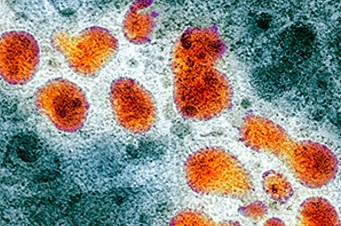H5N1 Circulating In Dairy Cows And Cats In America Are A New Strain: B3.13 Belonging To Clade 2.3.4.4b That Underwent Reassortment Events!
Nikhil Prasad Fact checked by:Thailand Medical News Team Apr 18, 2024 1 year, 8 months, 1 week, 6 days, 18 hours, 31 minutes ago
H5N1 News: Highly pathogenic avian influenza (HPAI) A (H5N1) viruses belonging to clade 2.3.4.4b have emerged as a significant global public health threat, impacting poultry, wildlife, and potentially humans. Recent developments in the United States have revealed a new strain, genotype B3.13, within this clade, affecting domestic dairy cattle and domestic cats. This
H5N1 News report delves into the origins, detection, genomic characterization, phylogenetic analysis, mutation adaptations, and potential implications of this novel HPAI virus strain.
 H5N1 Circulating In Dairy Cows And Cats In America Are A New
H5N1 Circulating In Dairy Cows And Cats In America Are A New
Strain: B3.13 Belonging To Clade 2.3.4.4b
Emergence and Spread of Clade 2.3.4.4b H5N1 Virus
The clade 2.3.4.4b H5N1 virus originated in East and Southeast Asia in 2020, primarily affecting avian species. Its subsequent spread globally via migratory birds and trade networks led to its introduction to North America in late 2021, followed by infections in wild terrestrial mammals across the continent. The Texas Panhandle, situated within major bird migratory flyways, experienced an outbreak in dairy cattle and domestic cats in early 2024, signaling a new phase of the virus's spread and adaptation.
Detection and Genomic Characterization
In February and March 2024, dairy cattle in Texas exhibited symptoms such as reduced feed intake and decreased milk production, while domestic cats showed similar signs after consuming raw colostrum and milk. Samples from affected animals tested positive for HPAI H5N1 clade 2.3.4.4b, leading to genomic sequencing that identified genotype B3.13, indicating reassortment events involving HPAI and low pathogenic avian influenza (LPAI) viruses.
The genomic analysis revealed that the B3.13 genotype had undergone two reassortment events since 2023, leading to critical mutations in genes such as HA, M1, and NS. Notably, these mutations did not include key changes in PB2 and PB1 genes associated with enhanced virulence or adaptation to mammalian hosts. However, a human case with the PB2 E627K mutation highlighted the virus's potential for rapid evolution post-infection, necessitating continued surveillance.
Phylogenetic and Reassortment Analysis
Phylogenetic analysis revealed a close relationship among viruses from dairy cattle, domestic cats, wild birds, and a human case, forming a distinct subcluster within clade 2.3.4.4b. Reassortment events between HPAI and LPAI viruses contributed to genotype B3.13, highlighting the virus's evolving nature and adaptability across species barriers.
Further analysis using the GenoFlu tool classified the B3.13 genotype as a result of reassortment involving genotype B3.7 and an LPAI virus strain. The HA, NA, PA, and MP genes originated from the H5N1 virus strain A1 in 2020, while other segments were closely related to LPAI viruses. This intricate reassortment pattern underscores the virus's dynamic genetic makeup and its potential for rapid ev
olution.
Critical Amino Acid Mutation Analysis
Amino acid mutation analysis identified key residues in the HA, M1, and NS1 genes associated with increased virulence and potential human receptor binding affinity. Notably, mutations linked to mammalian host adaptation and enhanced transmission were absent in HPAI viruses from dairy cattle and cats, mitigating immediate concerns for widespread human transmission.
Specifically, mutations in the HA gene residues 137A, 158N, and 160A were observed, which may increase binding affinity to human-type receptors. Additionally, mutations in M1 (30D, 43M, and 215A) and NS1 (42S, 103F, and 106M) were consistent with patterns observed in HPAI isolates from terrestrial and marine mammals, indicating potential virulence in mammalian hosts.
However, critical mutations associated with mammalian host adaptation and enhanced transmission, such as residues 591K, 627K/V/A, 701N in PB2, and 228S, were absent in all HPAI virus strains derived from dairy cattle and cats. This observation suggests that while the current risk to human health is relatively low, ongoing surveillance and vigilance are crucial due to the virus's potential for adaptive changes.
Implications and Public Health Concerns
The detection of HPAI H5N1 clade 2.3.4.4b in domestic dairy cattle raises concerns about zoonotic transmission through unpasteurized milk, necessitating public awareness and food safety measures. While current mutations pose a low immediate risk to human health, the virus's potential for rapid evolution underscores the need for continued surveillance and preparedness.
Additionally, the detection of the same strain of HPAI viruses in various wild bird species, such as blackbirds and common grackles in Texas and Canada geese in Wyoming (Central Flyway), provides further support for potential transmission routes. This includes direct contact or contamination of water sources and feed, highlighting the complex interplay between migratory birds, wildlife, and domestic animals in virus transmission dynamics.
Furthermore, the recent confirmation of this HPAI virus strain in dairy herds across multiple states emphasizes the need for coordinated response efforts and biosecurity measures within the agricultural sector. The interconnectedness of wildlife, livestock, and human populations necessitates a One Health approach to disease management, encompassing veterinary, public health, and environmental perspectives.
Conclusion
The emergence of HPAI H5N1 clade 2.3.4.4b in domestic dairy cattle and cats marks a significant development in the ongoing global influenza landscape. Understanding the virus's genomic characteristics, reassortment events, and mutation patterns is crucial for effective surveillance, outbreak management, and public health interventions to mitigate potential threats to human and animal populations. Continued research and collaboration across disciplines are essential in addressing the dynamic challenges posed by emerging infectious diseases like HPAI.
The study findings by researchers from Iowa State University-USA were published on a preprint server and are currently being peer reviewed.
https://www.biorxiv.org/content/10.1101/2024.04.16.588916v1
For the latest
H5N1 News, keep on logging to Thailand Medical News.
Read Also:
https://www.thailandmedical.news/news/breaking-h5n1-genotype-affecting-cows-in-america-possibly-gains-entry-into-humans-via-the-eyes-thru-the-new-pb2-e67k-mutation
https://www.thailandmedical.news/news/news-of-cats-dying-from-h5n1-in-texas-raises-alarms-as-dairy-cows-and-even-a-human-have-already-been-infected-with-the-new-strain
https://www.thailandmedical.news/news/no-agency-is-prepared-existing-h5n1-vaccines-and-antivirals-like-tamiflu-and-xofluza-do-not-work-against-the-new-h5n1-variants
